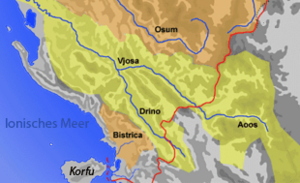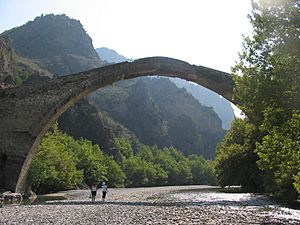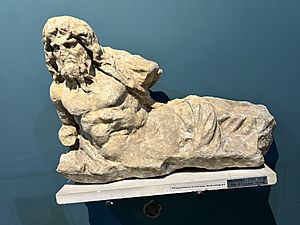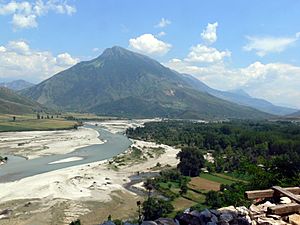Vjosa facts for kids
Quick facts for kids VjosaΑώος (Aoös) |
|
|---|---|

Mouth of Vjosa discharging into the Adriatic
|
|
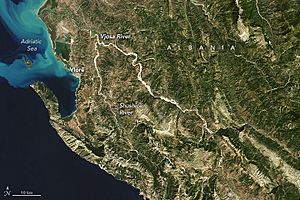 |
|
| Countries | Albania and Greece |
| Physical characteristics | |
| Main source | Pindus, Greece |
| River mouth | Adriatic Sea, Albania 0 m (0 ft) 40°38′34″N 19°19′2″E / 40.64278°N 19.31722°E |
| Length | 272 kilometres (169 mi) |
| Basin features | |
| Basin size | 6,706 km2 (2,589 sq mi) |
The Vjosa river, also known as Aoös, flows through northwestern Greece and southwestern Albania. It is about 272 kilometres (169 mi) long. About 80 kilometres (50 mi) of the river is in Greece, and the rest, 192 kilometres (119 mi), is in Albania.
The Vjosa river starts in the Pindus mountains in Greece. It then flows towards the northwest. The river enters Albania near Çarshovë and finally empties into the Adriatic Sea north of Vlorë. This river is mostly wild and clean. It is surrounded by the Vikos–Aoös National Park in Greece and the Vjosa-Narta Protected Landscape in Albania. In 2023, the Albanian part of the river became the Vjosa Wild River National Park. This park helps protect the river from new building projects.
Contents
Understanding the Vjosa River's Names
The Vjosa river has several different names. In ancient times, it was called Aoös in Greek and Aous in Latin. Today, in Albania, people call it Vjosë or Vjosa. In Greece, it is still known by its ancient name, Aoös.
Sometimes, in older Greek texts, it was also called Vovousa or Aias. The name Vjosa is also a common girl's name in Albania.
Exploring the Vjosa River's Path
The Vjosa river begins in the Pindus mountains of Epirus, Greece. It starts near a village called Vovousa. There is a lake and a dam built there since 1987, which helps produce electricity.
The river flows through the deep canyons of Vikos–Aoös National Park. Then it passes through the town of Konitsa. Here, another river called the Voidomatis joins the Vjosa.
The Vjosa then crosses into Albania near Çarshovë. The Sarantaporos river joins it here. The Vjosa continues flowing northwest through towns like Përmet, Këlcyrë, and Tepelenë. In Tepelenë, the Drino river adds its waters. The river then flows past Memaliaj, Selenicë, and Novoselë.
Finally, the Vjosa river flows into the Adriatic Sea northwest of Vlorë. The area where the river meets the sea is part of the Vjosa-Narta Protected Landscape.
Main Rivers Joining the Vjosa
The most important rivers that flow into the Vjosa are:
- The Sarantaporos and Voidomatis rivers in Greece.
- The Drino and Shushicë rivers in Albania.
Cities and Towns Along the River
Many towns and cities are located along the Vjosa river. Starting from where it begins and moving downstream, they include:
- In Greece: Vovousa and Konitsa.
- In Albania: Përmet, Këlcyrë, Çarshovë, Tepelenë, Memaliaj, Selenicë, and Novoselë.
The Vjosa River in Ancient Times
In ancient Greek stories, Aous was sometimes a name for Adonis, a god of beauty. There was also a king of Cyprus named Aous. Even a river and a mountain in Cyprus were called Aous.
Ancient writers like Hecataeus and Plutarch mentioned the river with different names like Aias or Anios. Later, writers like Polybius and Strabo used the name Aoös. A group of people called the Parauaioi got their name from living near this river.
The Vjosa river was also a place for important battles. In 274 BC, Pyrrhus of Epirus won a battle against Antigonus II Gonatas near the river. Later, in 198 BC, the Romans and Macedonians fought the Battle of the Aous here.
Long ago, the river flowed more to the north. But a big earthquake in the fourth century changed its path to where it is today. This earthquake and the river's new course caused the ancient Greek city of Apollonia to decline.
Protecting the Vjosa River
Conservation Efforts in Greece
The Vikos–Aoös National Park was created in Greece in 1973. This park covers about 126 square kilometres (31,135 acres) of mountains, rivers, lakes, and forests. The most famous part of the park is the Vikos Gorge, which was carved by the Voidomatis River. The Aoos Gorge and Mount Tymfi are also part of this beautiful park.
Conservation Efforts in Albania
In 2005, the Albanian government made the Vjose-Narte wetlands a protected area. This was done after Albania agreed to the Kyoto Protocol, an international agreement to protect the environment. The Vjosa river also provides water for a large irrigation canal built in the 1950s.
Many companies want to build dams on the Vjosa river to create electricity. By 2017, over 2000 dam projects were planned for rivers in the Balkans, including the Vjosa. However, environmental groups like RiverWatch, EuroNatur, and EcoAlbania are working hard to stop these projects.
A study in 2012 showed that many rivers in the Balkans are still in good condition. About 30% are untouched, and 50% are only slightly changed by humans.
In 2020, environmental groups started a campaign to make the entire Vjosa river a national park. Their goal was to create Europe's first wild river park, protecting about 300 km of rivers and streams.
In September 2020, Albanian Prime Minister Edi Rama announced that a protected area would be created around the Vjosa. In December 2020, the government officially called it a "Managed Nature Reserve." However, environmental groups were worried this protection might not be strong enough. A national park status would completely stop dams and other building projects. A "protected area" status might not.
In April 2021, scientists who study the Vjosa river sent a petition to the Albanian President. They were very concerned about a plan to build a 50-meter high dam. This dam would be the first to change the flow of the Albanian part of the river. It would flood areas with many animal and plant species, some of which are endangered. It would also destroy farms, harm the river's fish, and force many people to leave their homes. Activists believe the government should use other ways to get energy that don't harm the river.
See also
 In Spanish: Río Viosa para niños
In Spanish: Río Viosa para niños
- List of rivers of Albania
- List of rivers of Europe
- List of rivers of Greece


